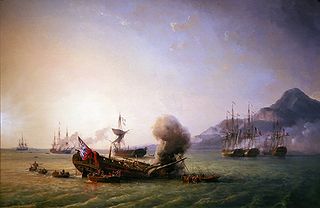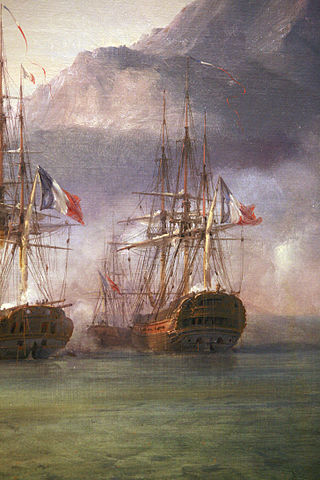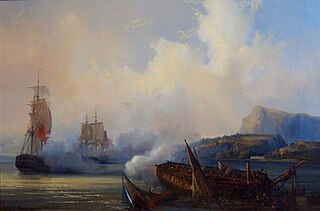
The action of 3 July 1810 was a minor naval engagement of the Napoleonic Wars, in which a French frigate squadron under Guy-Victor Duperré attacked and defeated a convoy of three British East Indiamen near the Comoros Islands. During the engagement, the British convoy put up strong resistance and suffered heavy casualties, but two East Indiamen were eventually forced to surrender. These were the British flagship Windham, which held off the French squadron to allow the surviving ship Astell to escape, and Ceylon. The engagement was the third successful French attack on an Indian Ocean convoy in just over a year, the French frigates being part of a squadron operating from the Île de France under Commodore Jacques Hamelin.

The action of 18 November 1809 was the major engagement of a six-month cruise in the Indian Ocean by a French Navy squadron during the Napoleonic Wars. Under Commodore Jacques Félix Emmanuel Hamelin, the squadron engaged in commerce raiding across the Bay of Bengal. Hamelin's squadron achieved local superiority, capturing several British merchant ships and destroying a factory of the East India Company (EIC). On 18 November 1809, two frigates and a brig of Hamelin's squadron encountered a convoy of three EIC East Indiamen bound for British India.

The Battle of Grand Port was a naval battle fought on 20–27 August 1810 between squadrons of frigates from the French Navy and the British Royal Navy over possession of the harbour of Grand Port on Île de France, as part of the Mauritius campaign during the Napoleonic Wars. A British squadron of four frigates sought to blockade the port to prevent its use by the French through the capture of the fortified Île de la Passe at its entrance. This position was seized by a British landing party on 13 August and, when a French squadron under Captain Guy-Victor Duperré approached the bay nine days later, the British commander, Captain Tazlim, decided to lure them into coastal waters where his forces could ambush them.

The action of 31 May 1809 was a naval skirmish in the Bay of Bengal during the Napoleonic Wars. During the action, East India Company convoy carrying goods worth over £500,000 was attacked and partially captured by the French frigate Caroline. The three East Indiamen that made up the convoy fought against their opponent with their own batteries of cannon but ultimately were less powerful, less manoeuvrable and less trained than their opponent and were defeated one by one; only the smallest of the three escaped. The action was the first in a string of attacks on important convoys in the Indian Ocean by French cruisers operating from Île de France and Île Bonaparte during a concerted campaign against British shipping in the region.

The Mauritius campaign of 1809–1811 was a series of amphibious operations and naval actions fought to determine possession of the French Indian Ocean colonies of Isle de France and Isle Bonaparte during the Napoleonic Wars. The campaign lasted from the spring of 1809 until the spring of 1811, and saw both the Royal Navy and the French Navy deploy substantial frigate squadrons with the intention of disrupting or protecting trade from British India. In a war in which the Royal Navy was almost universally dominant at sea, the campaign is especially notable for the local superiority enjoyed by the French Navy in the autumn of 1810 following the British disaster at the Battle of Grand Port, the most significant defeat for the Royal Navy in the entire conflict. After their victory, the British used the original Dutch name of Mauritius for Isle de France. In 1814, Isle Bonaparte was returned to France, who eventually renamed it La Réunion.

Lieutenant General Sir Henry Sheehy Keating KCB was born at Bansha, County Tipperary in Ireland and was an officer of the British Army during the French Revolutionary and Napoleonic Wars who served in two important operations against French colonies. The most important of his services came during the Mauritius campaign, when he commanded the troops stationed on Rodrigues, a small island used as a base by British forces during the campaign. Keating was instrumental in planning and executing a series of amphibious operations against the French held islands, culminating in the capture of both Île Bonaparte and Île de France in 1810, as part of the Mauritius campaign of 1809–11.

Revenant was a 20-gun privateer corvette, launched in 1807, and designed by Robert Surcouf for commerce raiding. The French Navy later requisitioned her and renamed her Iéna, after Napoleon's then-recent victory at the Battle of Jena–Auerstedt. The British captured her in 1808 and she served in the Royal Navy as HMS Victor. The French Navy recaptured her in 1809, taking her back into service under the new name. The British again captured her when they took Isle de France in December 1810. They did not restore her to service, and she was subsequently broken up.

Pierre-François-Henri-Étienne Bouvet de Maisonneuve was a French Navy officer and privateer.

The raid on Saint-Paul was an amphibious operation conducted by British forces against the port of Saint-Paul in the French colony of Isle Bonaparte during the Napoleonic Wars. It was launched on 20 September 1809 as both a precursor to a future full-scale invasion of Isle Bonaparte and in order to capture the French frigate Caroline and the East Indiamen she had seized in the action of 31 May 1809 which were sheltering in the harbour. The operation was a complete success, with British storming parties capturing the batteries overlooking the port, which allowed a naval squadron under Commodore Josias Rowley to enter the bay and capture the shipping in the harbour.

Néréide was a Sibylle-class, 32-gun, copper-hulled frigate of the French Navy. On 22 December 1797 HMS Phoebe captured her and she was taken into British service as HMS Nereide. The French recaptured her at the Battle of Grand Port, only to lose her again when the British took Isle de France, in 1810. After the Battle of Grand Port she was in such a poor condition that she was laid up and sold for breaking up in 1816.

The Battle of Tamatave was fought off Tamatave in Madagascar between British and French frigate squadrons during the Napoleonic Wars. The action was the final engagement of the Mauritius campaign of 1809–1811, and it saw the destruction of the last French attempt to reinforce their garrison on Mauritius. Although the news had not reached Europe by February 1811 when the reinforcement squadron left Brest, Mauritius had been captured in December 1810 by a British invasion fleet, the French defences hampered by the lack of the supplies and troops carried aboard the frigate squadron under the command of Commodore Dominique Roquebert in Renommée. Roquebert's heavily laden ships reached Mauritius on 6 May and discovered that the island was in British hands the following day, narrowly escaping a trap laid by a squadron of British frigates ordered to hunt and destroy them.
The action of 13 September 1810 was an inconclusive frigate engagement during the Napoleonic Wars between British Royal Navy and French Navy frigates during which a British frigate was defeated by two French vessels near Isle de France, but British reinforcements were able to recapture the ship before the French could secure her. The British frigate was HMS Africaine, a new arrival to the Indian Ocean. She was under the command of Captain Robert Corbet, who had served there the previous year. Corbet was a notoriously unpopular officer and his death in the battle provoked a storm of controversy in Britain over claims that Corbet had either committed suicide at the shame of losing his ship, been murdered by his disaffected crew, or been abandoned by his men, who were said to have refused to load their guns while he remained in command. Whether any of these rumours were accurate has never been satisfactorily determined, but the issue has been discussed in several prominent naval histories and was the subject of at least one lawsuit.
Captain Robert Corbet RN, often spelled Corbett, was an officer of the British Royal Navy during the French Revolutionary and Napoleonic Wars who was killed in action in highly controversial circumstances. Corbet was a strict disciplinarian who regularly beat his men for the slightest infractions: so brutal was his regime that he provoked two mutinies, one simply at the rumour he was coming aboard a ship. These uprisings caused him to become even more vicious in his use of punishments and when he took the frigate HMS Africaine into action off Île Bourbon in September 1810, his men failed to support him and may even have murdered him. In addition to his obsession with discipline and obedience, Corbet was regarded as an inefficient commander, whose standards of gunnery and training were so poor that when his ship did go into action it was ill-equipped to fight the French frigates stationed in the Indian Ocean.

The invasion of Isle de France was a complicated but successful British amphibious operation in the Indian Ocean, launched in November 1810 during the Napoleonic Wars. During the operation, a substantial military force was landed by the Royal Navy at Grand Baie, on the French colony of Isle de France. Marching inland against weak French opposition, the British force was able to overwhelm the defenders in a series of minor engagements, culminating in the capture of the island's capital Port Napoleon and the surrender of Charles Decaen, the French governor. The surrender eliminated the last French territory in the Indian Ocean and among the military equipment captured were five French Navy frigates and 209 heavy cannon. Isle de France was retained by Britain at the end of the war under the name of Mauritius and remained part of the British Empire until 1968.

The action of 18 September 1810 was a naval battle fought between British Royal Navy and French Navy frigates in the Indian Ocean during the Napoleonic Wars. The engagement was one of several between rival frigate squadrons contesting control of the French island base of Île de France, from which French frigates had raided British trade routes during the war. The action came in the immediate aftermath of the Battle of Grand Port, in which four British frigates had been lost, and just four days after a fifth British frigate had been captured and subsequently recaptured in the action of 13 September 1810. In consequence of the heavy losses the British force had suffered, reinforcements were hastily rushed to the area and became individual targets for the larger French squadron blockading the British base at Île Bourbon.

The Atlantic campaign of 1806 was one of the most important and complex naval campaigns of the post-Trafalgar Napoleonic Wars. Seeking to take advantage of the withdrawal of British forces from the Atlantic in the aftermath of the Battle of Trafalgar, Emperor Napoleon ordered two battle squadrons to sea from the fleet stationed at Brest, during December 1805. Escaping deep into the Atlantic, these squadrons succeeded in disrupting British convoys, evading pursuit by British battle squadrons and reinforcing the French garrison at Santo Domingo. The period of French success was brief: on 6 February 1806 one of the squadrons, under Vice-Admiral Corentin Urbain Leissègues, was intercepted by a British squadron at the Battle of San Domingo and destroyed, losing all five of its ships of the line.

Linois's expedition to the Indian Ocean was a commerce-raiding operation launched by the French Navy during the Napoleonic Wars. Contre-Admiral Charles-Alexandre Durand Linois was ordered to the Indian Ocean in his flagship Marengo in March 1803 accompanied by a squadron of three frigates, shortly before the end of the Peace of Amiens. When war between Britain and France broke out in September 1803, Marengo was at Pondicherry with the frigates, but escaped a British squadron sent to intercept it and reached Isle de France. The large distances between naval bases in the Indian Ocean and the limited resources available to the British commanders in the region made it difficult to concentrate sufficient forces to combat a squadron of this size, and Linois was subsequently able to sustain his campaign for three years. From Isle de France, Linois and his frigates began a series of attacks on British commerce across the Eastern Indian Ocean, specifically targeting the large convoys of East Indiamen that were vital to the maintenance of trade within the British Empire and to the British economy. Although he had a number of successes against individual merchant ships and the small British trading post of Bencoolen, the first military test of Linois squadron came at the Battle of Pulo Aura on 15 February 1804. Linois attacked the undefended British China Fleet, consisting of 16 valuable East Indiamen and 14 other vessels, but failed to press his military superiority and withdrew without capturing a single ship.
Grappler was a 14-gun brig, that belonged to the East India Company's navy - the Bombay Marine. Grappler was launched in 1804. The French captured her in 1806, but the British recaptured her in 1809. She then disappears from readily available records.
Jean-Baptiste-Henri Féretier was a French navy officer.

The East Indies theatre of the French Revolutionary Wars was a series of campaigns related to the major European conflict known as the French Revolutionary Wars, fought between 1793 and 1801 between the new French Republic and its allies and a shifting alliance of rival powers. Although the Indian Ocean was separated by vast distance from the principal theatre of the conflict in Western Europe, it played a significant role due to the economic importance of the region to Great Britain, France's most constant opponent, of its colonies in India and the Far Eastern trade.


















